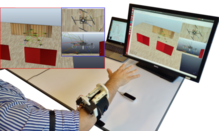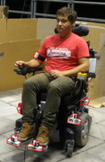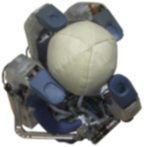
Heterogeneous Team of Humans and Robots
Teams of coordinated robots have been proven useful in several high-impact applications, including urban search and rescue (USAR), disaster response, counter terrorism, patrolling, surveillance, and mapping. However, as these scenarios are generally highly dynamic and unstructured, it is often important to enable human operators to control the robotic systems in a reactive, effective, and intuitive way. In this context, my work has been to study and develop intuitive, yet effective, paradigms for providing the human operator with the best possible means to control the robot(s), as well as informing him or her on the status of the robot(s) and the surrounding environment.
Haptic feedback for remote teleoperation
Teleoperation is one of the pillar areas of robotics since its modern conception in the previous century. Being able to remotely operate a robotic system is fascinating. However, the operator must be constantly aware of what is going on in the remote environment; otherwise it is no different than driving blindfolded. In this context, I designed new ungrounded haptic devices and employed them in various teleoperation scenarios. For example, I led the development of a multisensory haptic armband able to provide, all at the same time, vibrotactile sensations, skin stretch, and pressure to the forearm. This device was used for the teleoperation of a team composed of multiple drones as well as for the control of two robotic manipulators.


Assistive and Medical Robotics
Robotics is a medium of progress that, through automation, often means faster development and manufacturing. Robotics, however, can be beneficial to many sectors other than manufacturing. A paramount example is healthcare. In this context, I developed robotic solutions helping: power wheelchair users, using obstacle avoidance, path planning techniques, and wearable haptic rendering for navigating them in indoor environments; visually-impaired people, using teleoperation-like actions via wearable haptic feedback for remotely suggesting turning direction to navigate a city; the elderly, using obstacle avoidance and path planning techniques for navigating elderly users with haptic-enabled walkers in indoor environments.
Misc
I have always loved to challenge myself in other fields, taking advantage of the great multidisciplinary of my work and experience. For this reason, I have also published works in the fields of medical robotics, rehabilitation, robotic manipulation, and active perception.
